Welcome to another sketchbook tour, we haven’t had one of these in a while. During this winter, I really focused on pencil drawings, since I was working on my recently released drawing class at the same time. I’ve forgotten what a versatile, expressive medium a single pencil can be. I experimented a bit with inks and colored pencils, too, so there are dashes of color on these pages.
Overall, I’ve mostly used mechanical pencils, one with HB and one with B softness. I love that I don’t have to sharpen them, they have an eraser at the back, and you can get a surprising variety of lines out of the tips, depending on how you hold them.
Mechanical pencils are probably my most used tool these days. I like the thin ones by Faber Castell (TK Fine or Grip), they are slim and light, the plastic doesn’t feel cheap and the mechanism is sturdy. I had two mechanical pencils from Tombow that were nice to draw with, but I found them a bit bulky and the mechanism simply stopped working one day. So I went back to the Faber Castell models. I keep losing the caps, but I guess that simply means the eraser is more accessible!
Here’s a video version of this post:
Sketchbook Tour Winter/Spring 2022: trees, architecture and spring plants (video)
This winter I really focused on the shapes of branches and trees. I found the process of close observation quite meditative, and I noticed it has really helped me in understanding how I can render trees. Also every tree is an individual, even though there are shared characteristics among the same species. At the same time, I studied old master paintings with a lot of winter trees – Brueghel instantly comes to mind.
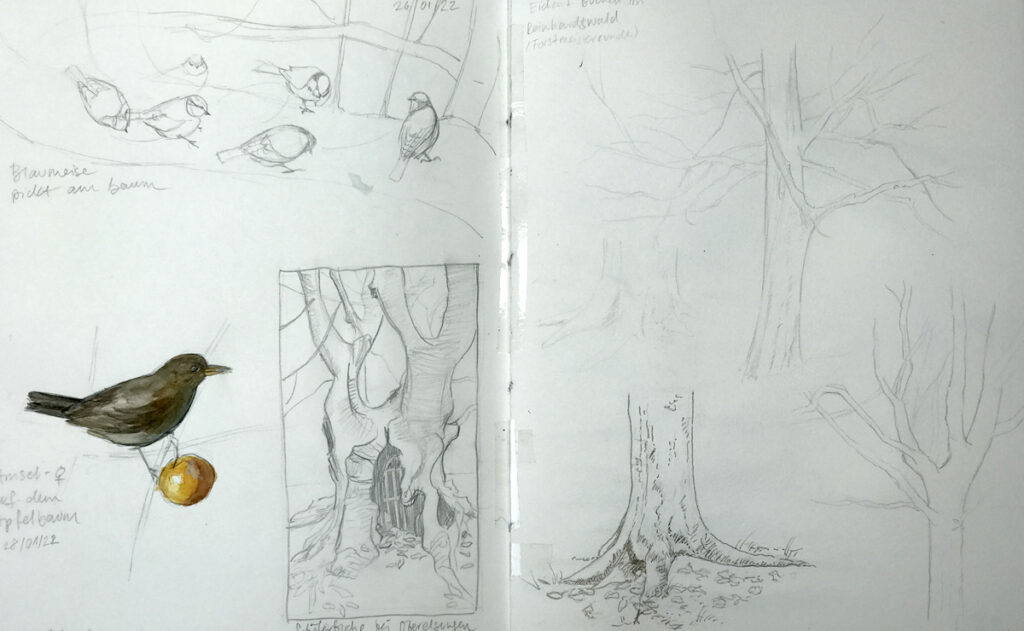
I reached for my paints after an encounter with a great crested grebe and some badger tracks. I think I already shared this page when I was deep in class-creation mode. For the house and mill wheel on the right, I used colored pencils, I really like the soft line quality they have. Somehow, this spread has a very wintery feel due to the colors.
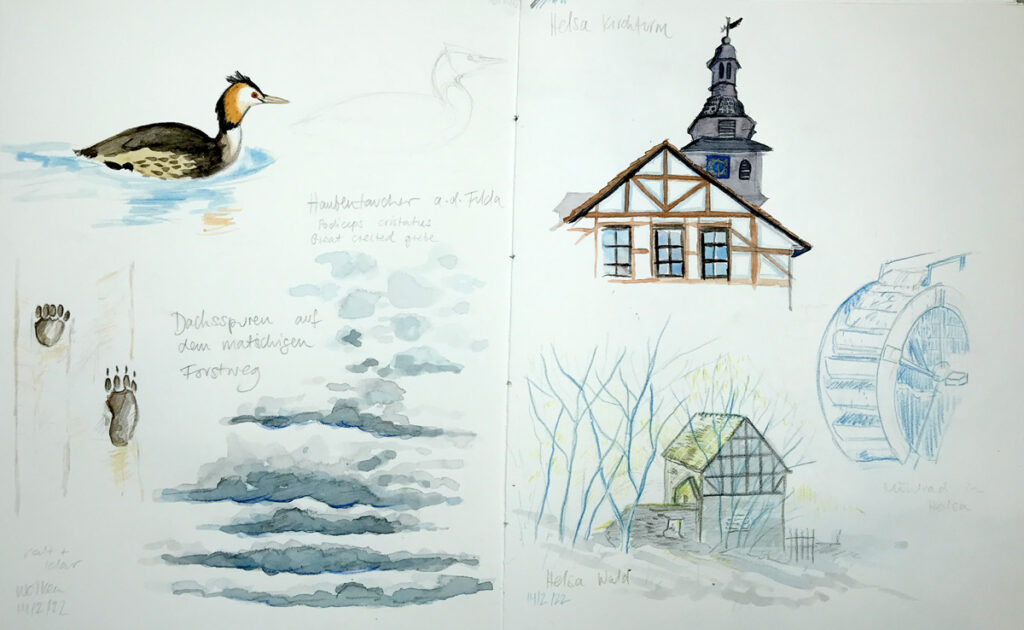
Another page with small studies of landscape elements and architectural details. We visited a lot of these small villages and I remember being really interested in the patterns that the roofs create.
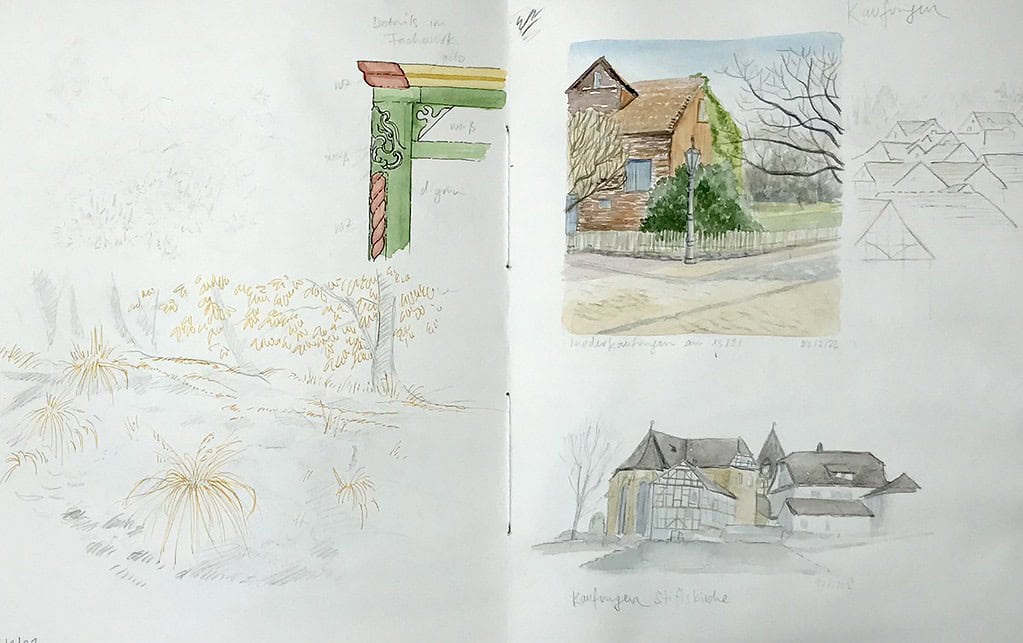
A slightly weird page that I would usually leave out, but I want to show you that not every sketchbook page has to look nice or make visual sense. On the right side, I spilled something, so I covered that spot with a tree study, and the rest, bird, plant and landscape don’t really hang together in any meaningful way. This is one of the pages that could probably be salvaged with a few text elements.
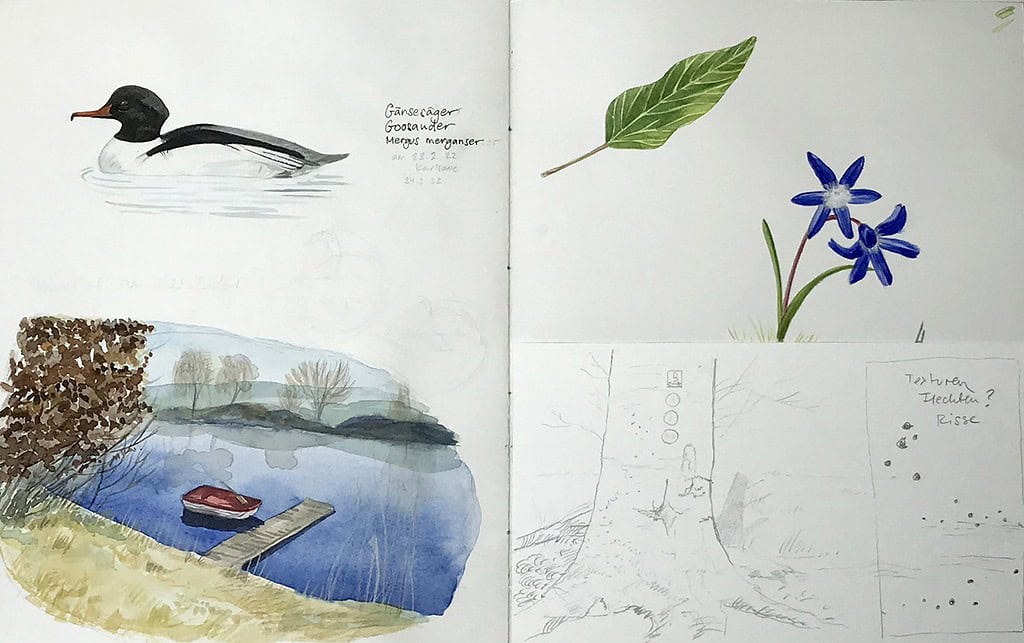
The following pages are material from the Sketching Fundamentals class. It was really fun to put together a spread with different types of small landscapes. I have to say over the course of this class I’ve come to really enjoy pencil-only drawings. On the right, I’ve shown different ways to render rocks.
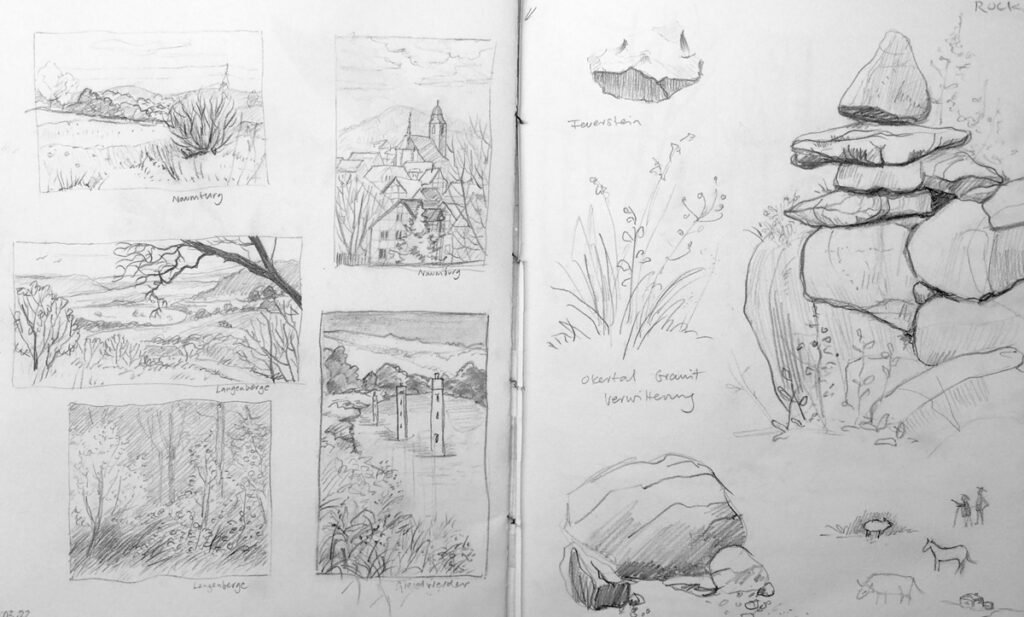
More small landscape demos, this time showing how to render different water situations and snow.
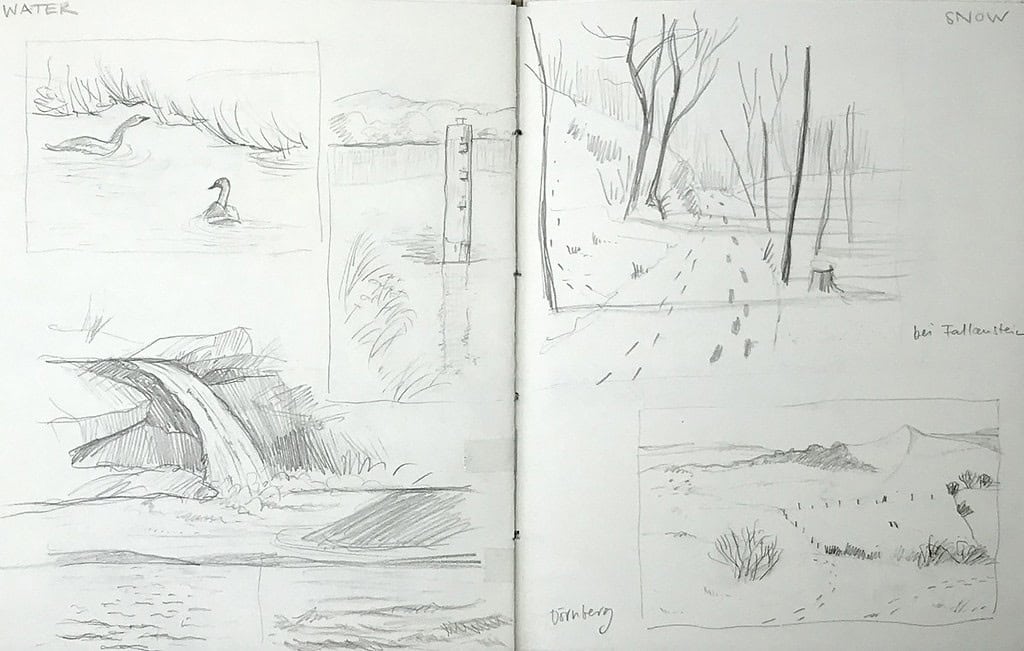
On the left side a first version for different kinds of clouds, I ended up redoing it. On the right side I did the first random sketching for myself in weeks, these were the first spring days with the vegetation finally waking up, as well as a few of my tomato and pepper seedlings.

The second version of my cloud lesson, and a colored study sheet of Corydalis cava, a plant that grows in spring in the forest everywhere, and then retreats into the ground until the next year.

This kingfisher study page was for a demo for my sketching class, I really enjoyed showing the hunting process of the bird. And it’s one of the rare occasions in the class which adds color – I didn’t want to overcomplicate those basic drawing lessons with yet another big topic that wants to be studied for itself.
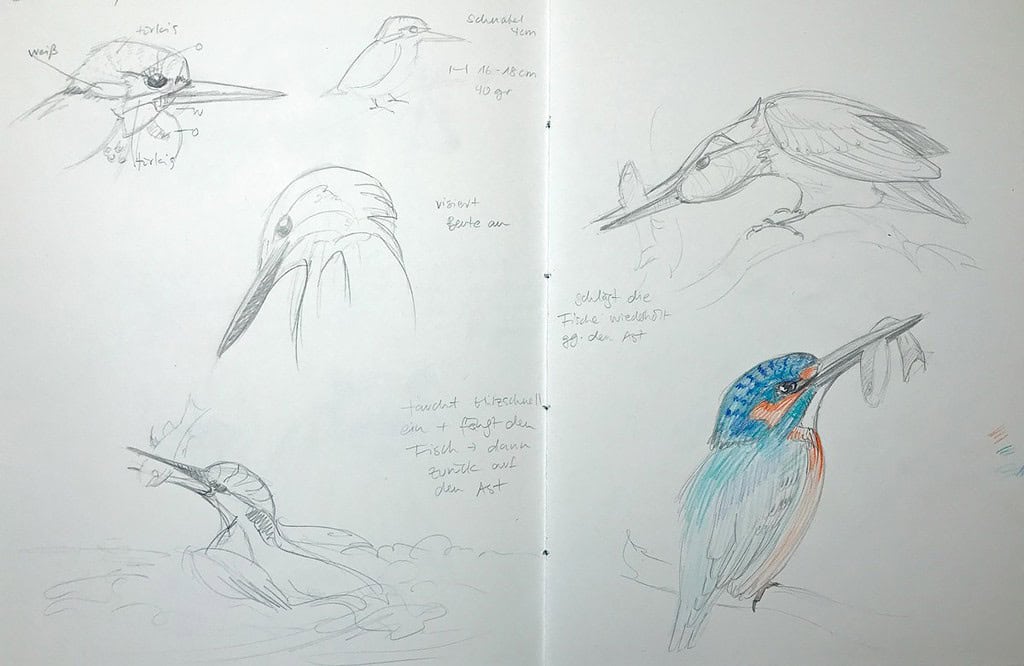
And finally, a classic nature sketchbook page. I put together different species that are typical for the beginning of spring (although I haven’t seen the orange tip yet this year). After my long months of mainly using pencils, it was nice to reintroduce color, but I also notice that I like to focus more on the drawing aspect of the sketches now. I messed up the hind wing of the orange tip, so I covered it with a matching piece of paper – it gives a nice 3d effect I think.
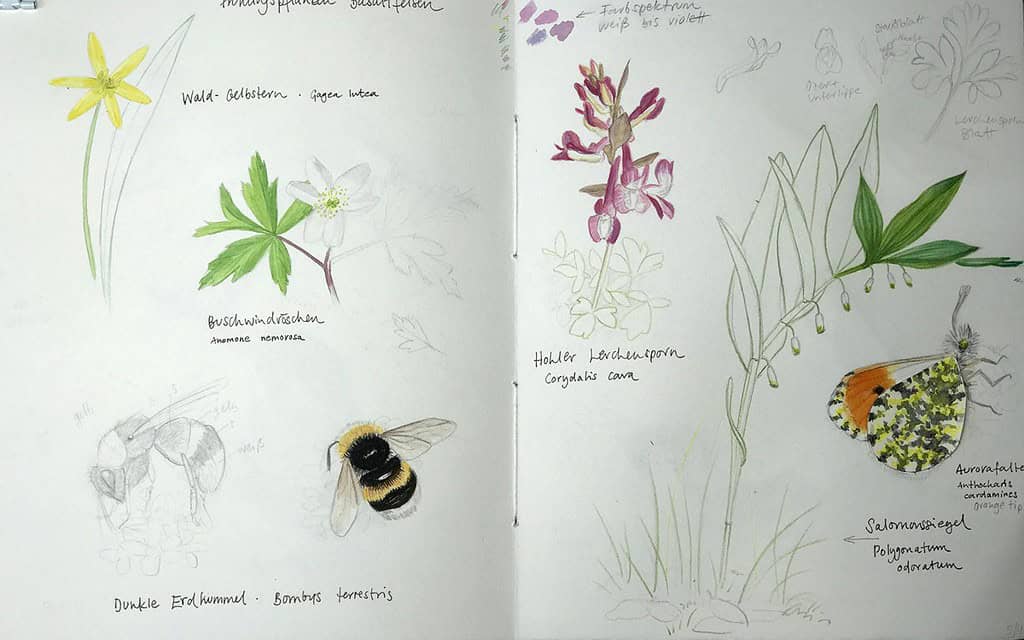
Two more study pages for the broad-bordered bee hawk-moth (what a long name!) and the blackcap. These kind of study pages are for me to get more familiar with a species, and to get comfortable with drawing its features. I enjoyed studying the intricate details of the moth wing (the middle parts are transparent) and the caterpillar. The blackcap is just an adorable small bird that I love to watch, and quite the gifted singer, too. I’ve never seen their eggs, but they seem to be so small (around 2,5cm/1 inch).
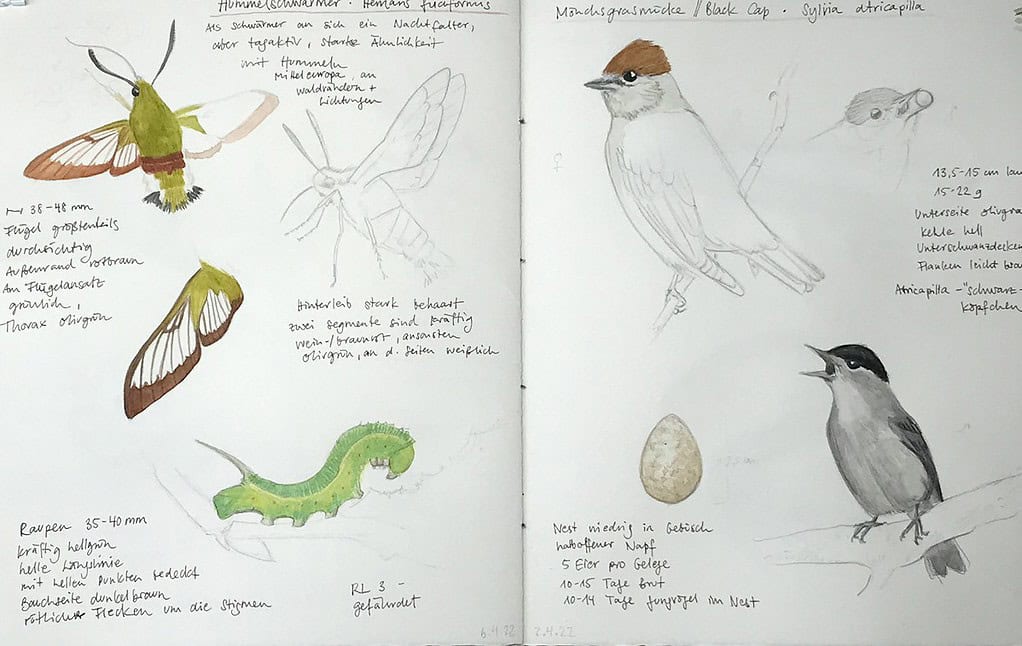
A page with two common lizards that I liked better before I added color to them. I consider this an unfinished page as I might go back to add in some elements. Note to myself: don’t add more layers of paint, however much they might granulate. It just won’t be visible on this smooth paper. (I had the idea to bring out a bit more interesting texture by doing this, but failed). On the right side, just a relaxing hour that I spent with studying a dandelion. After that, my collected plant parts had dried and shriveled, and I just had a tiny bit of time to add watercolor to two sketches.
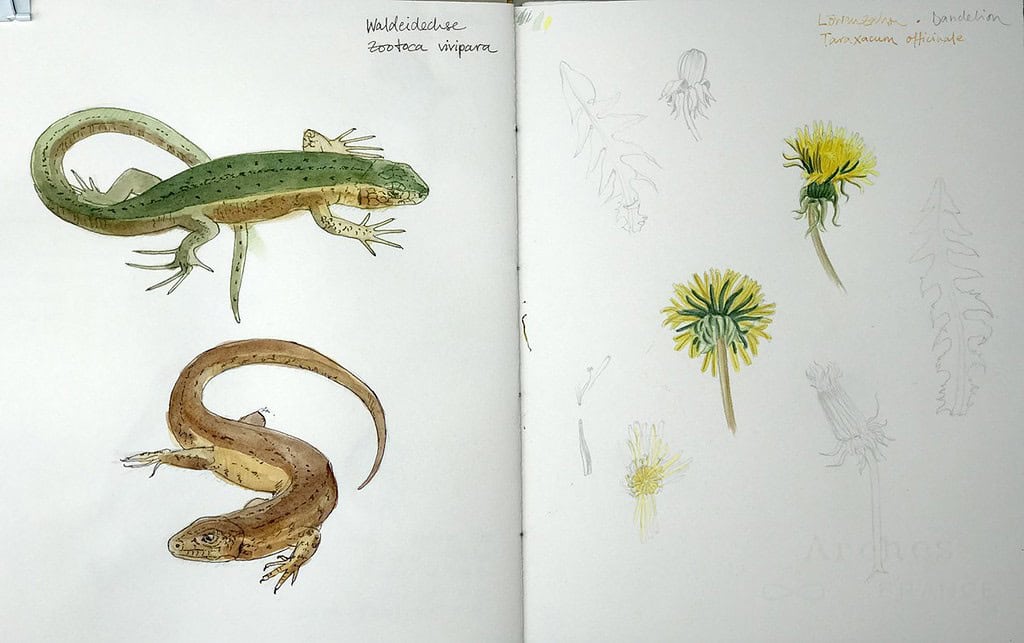
All in all, I’ve noticed slight changes in my sketchbook practice in recent months. As I’ve said, I now enjoy the drawing stage more – maybe I’ve become a better draughtsperson because I focused on teaching it, or maybe I’ve just done more of it. In any case, I’ve discovered that pencil is actually a medium that I enjoy very much. I used to not care about my own pencil drawings at all, and just saw them as the necessary stage for adding watercolor on top. I can only urge you to explore drawing tools like pencils, colored pencils, or ink.
I hope you’ve enjoyed this sketchbook tour, and maybe you’ve went through a similar process of discovery with a technique or tool. I’d love to hear about it.
Resources:
Sketching Fundamentals class



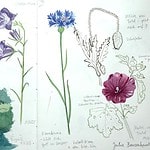
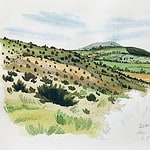
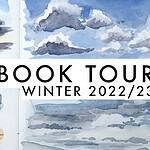
Julia, your sketches awaken every little wanna-be artistic inspiration in me and although a true beginner, recognize that the only way to become skilled, as are you, is to DO it and not be overwhelmed with my mistakes and inexperience. Thank you so very much for sharing so many of your beautiful drawings, a few mistakes, color palettes and your passion for painting and teaching. I will buy courses when I can, but enjoy the ‘eye-candy’ of what you share for free, for now. Marcy Thobaben
Dear Marcy, thank you so much for your kind words!
Yes, try to be welcoming to mistakes and inexperience, as weird as that sounds. There is nothing as helpful as things that seemingly go wrong, because you will have gained the experience of how to correct them (or at the very least not repeat them).
And sure, practice is a big part of getting better. I found keeping a sketchbook or nature journal an excellent way to practice regularly and also a safe way to mess up a lot. If it’s as much about observing things in nature as it is about artistic growth, then it doesn’t matter as much if the result is not as pretty. What I show here is a very polished version of a nature journal!
I really hope you will find something useful for your own artistic path in each of my posts, enjoy the journey!
Hi Julia, what a treat to get to look through your sketchbook. Its beautiful and you just keep getting better and better.
I also have used my pencil more than I used to. I used to try to pack every art supply I thought I would need. Nowadays I take 2 pencils, a sharpener and my sketchbook. I love the simplicity. Thank you again for the tour. (I’m waiting for your book) 😉
Cindy
Thank you very much Cindy! That sounds like a really simple, practical and completely functional sketching kit to me. A book…oh I’ve actually given that some thought, but a book of any kind would be a long-term project and I will need more material and more thinking. 😉 Maybe this summer will bring lots of new sketches.
I loved this sketchbook tour. Thank you for sharing your work. You have really inspired me to draw more